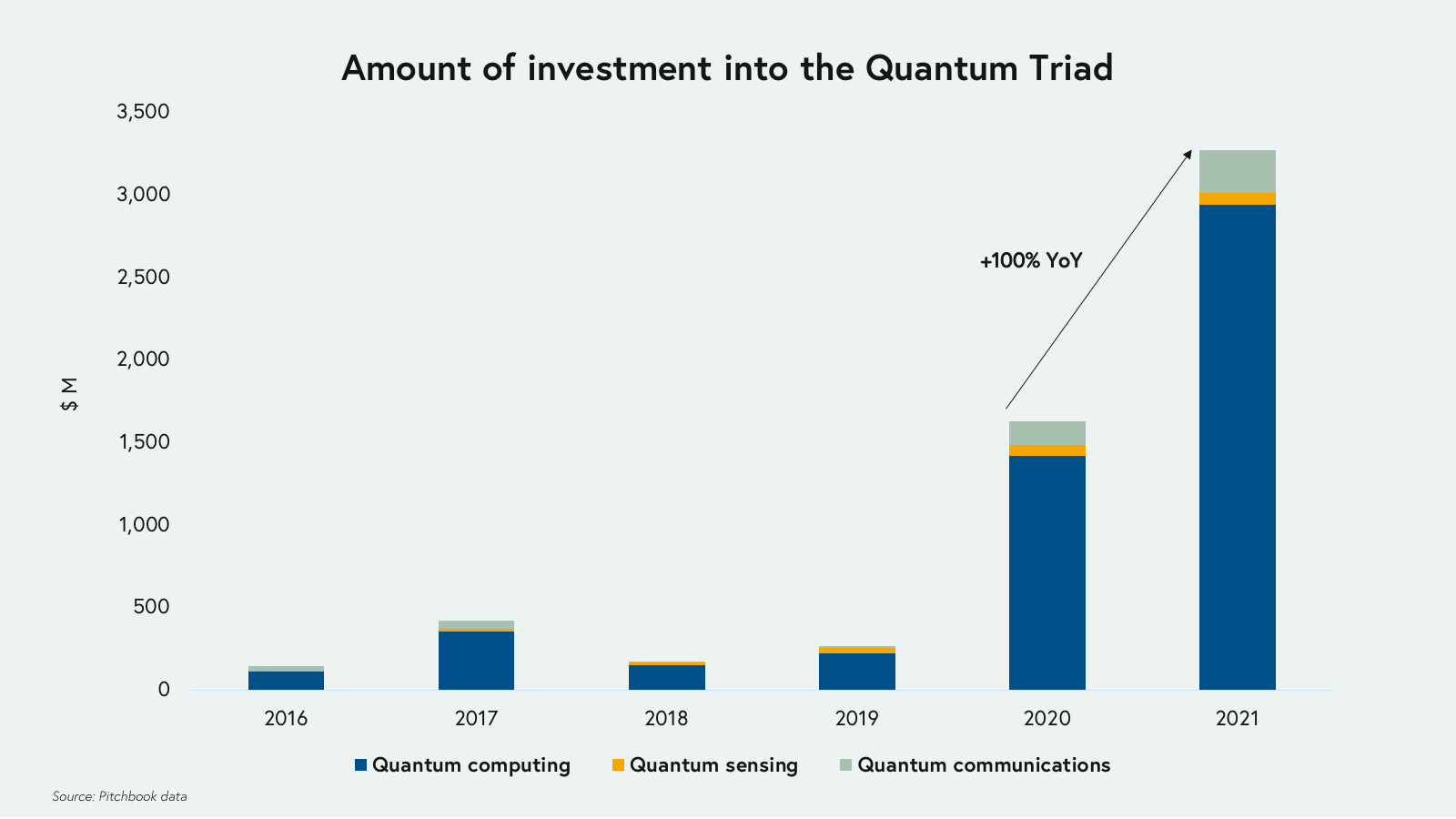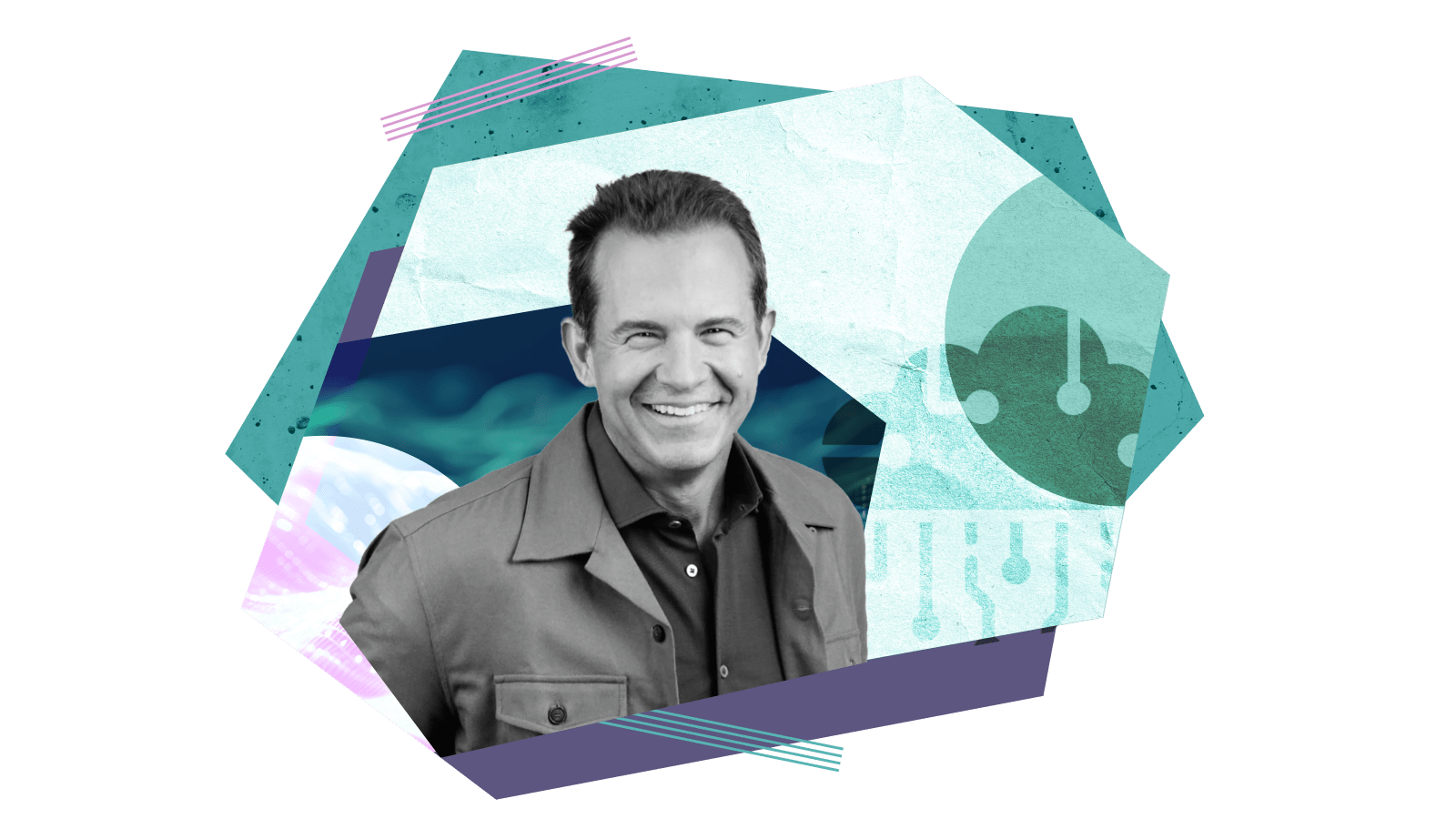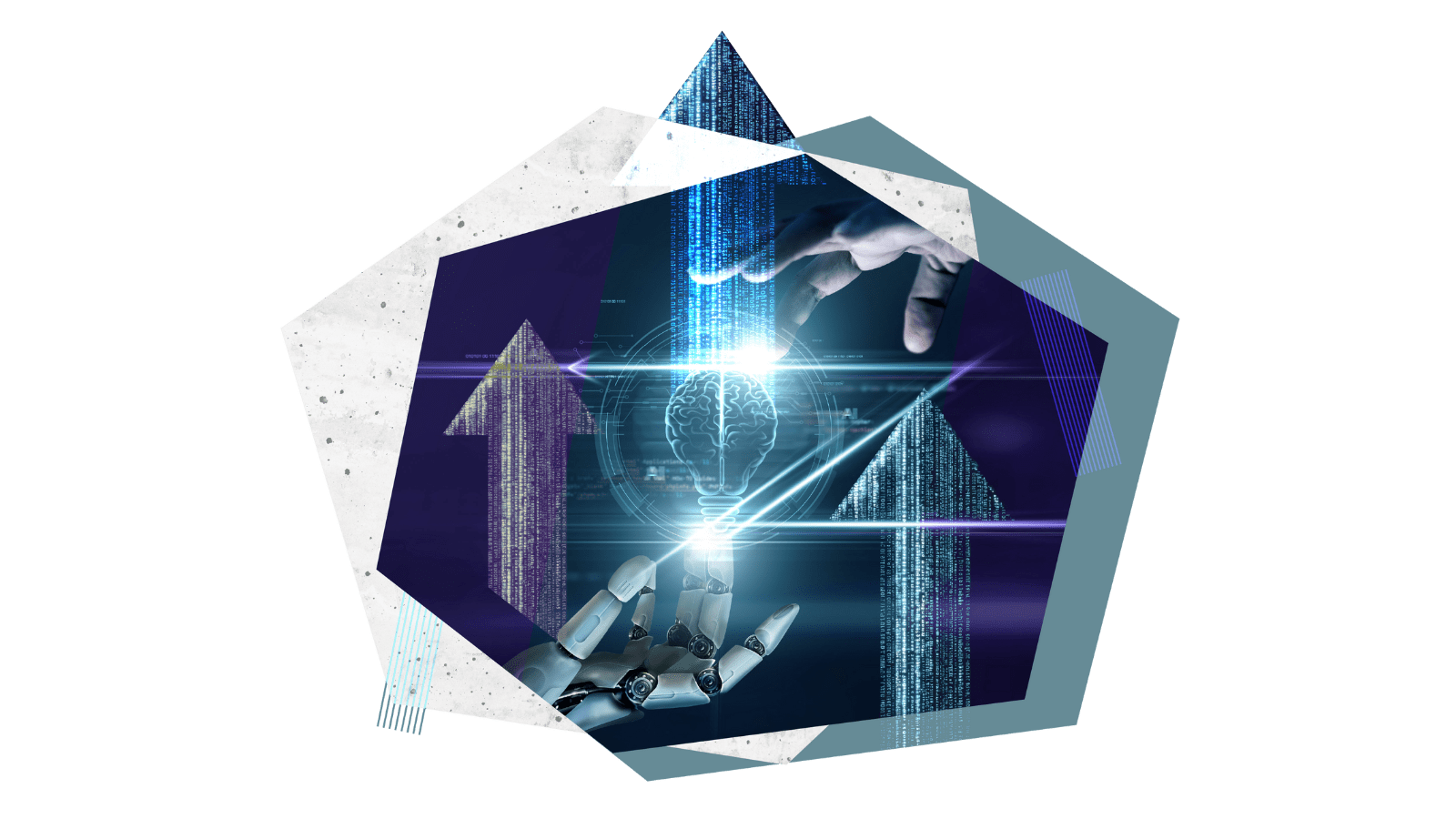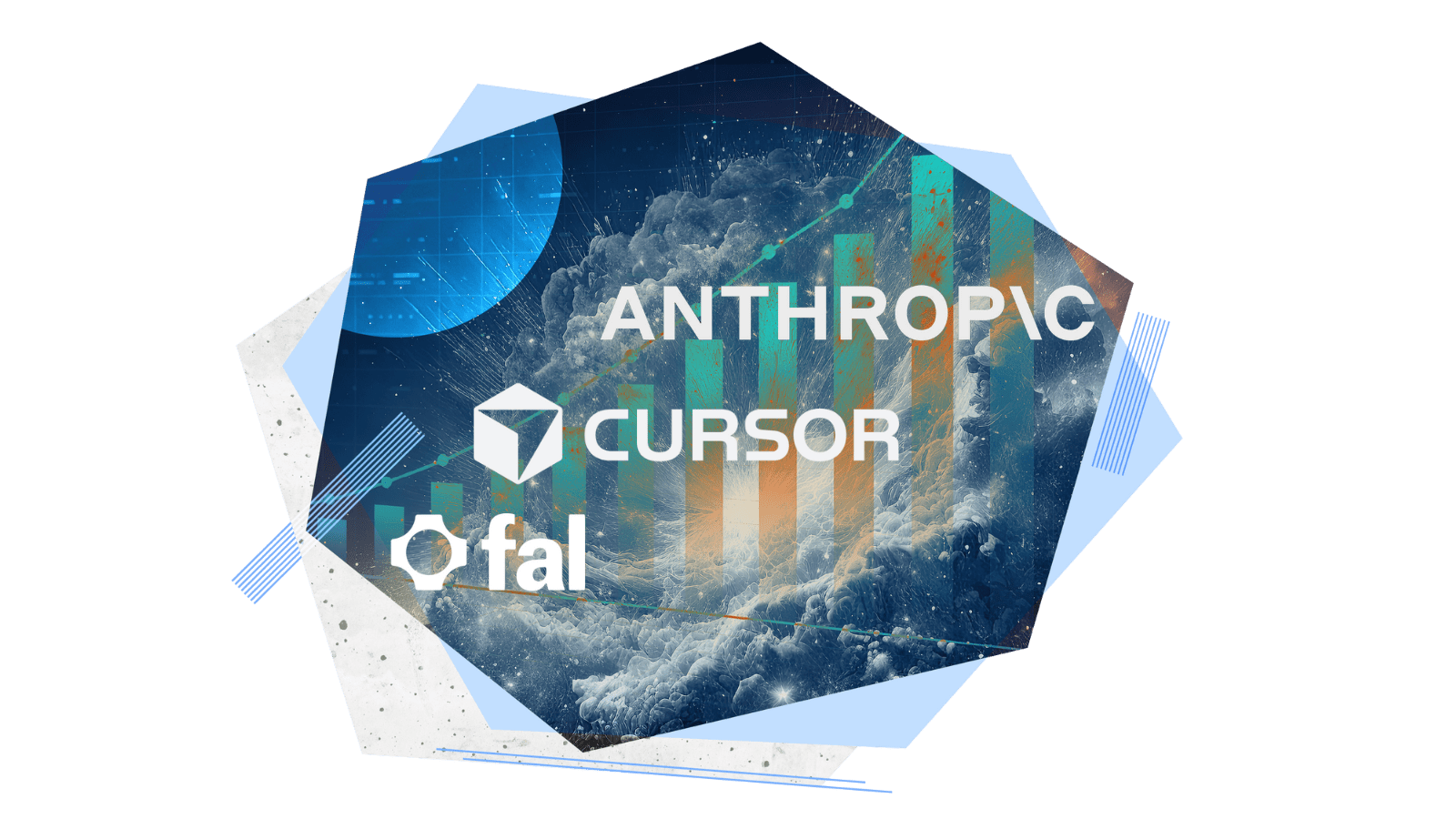Exploring the quantum triad: Quantum sensing
Quantum sensors are the next frontier of sensing, as they can unlock innovation in frontier applications like brain-computer interfaces and precise position, navigation, and timing.
Over the past few years, interest in quantum has converged on computing in particular, but it’d be a mistake to conclude that quantum computing is the totality of quantum. In reality, the practical applications of quantum mechanics form what we call a “quantum triad.” While quantum computing leads at the helm, the other two legs of the triad include quantum sensing and quantum communications.
We’ve previously written about our views on quantum computing, arguing that the race to quantum advantage is a marathon but will ultimately revolutionize fields like chemistry, logistics, and finance. Today, we explore the promise of quantum sensing as a novel technology that will revolutionize the way we measure the world around us.

How quantum sensors work
A sensor at its most basic level is merely something that measures physical phenomena. Not only do we have our own biological sensors like our eyes and ears, but we’ve also been building sensors for thousands of years. Early civilizations built scales to measure the weight of goods for trade, sundials to measure changes in time and season, and compasses to measure changes in direction. Today, our smartphones come equipped with gyroscopes to measure the tilt of the phone and accelerometers that measure, well, acceleration.
Quantum sensors are the next frontier of sensing, as they can unlock innovation in frontier applications like brain-computer interfaces and precise position, navigation, and timing. A quantum sensor measures changes in the environment by taking advantage of the fragility in quantum states. Indeed, we previously wrote that there is “this seemingly bizarre yet proven nature of the universe that until a particle interacts with another, its position, speed, color, spin, and other quantum properties co-exist simultaneously as a probability distribution over all possibilities.” This state is called “superposition.” The probability distribution of a superposition state changes over time as outside forces act upon the particle. Quantum sensing assesses the change in this probability distribution and works backwards to calculate the magnitude of the outside force that acted upon the particle.
Like quantum computers, quantum sensors can be implemented in different modalities depending on what physical property is being measured. Charged systems, like trapped ions, will be sensitive to electrical fields, spin-based systems will mainly respond to magnetic fields, and spatial systems will respond to gravity.
Quantum sensors vs. classical sensors
At first blush, this may not seem particularly revolutionary (after all, we have products like accelerometers, gyroscopes, and clocks that already work pretty well!). However, quantum sensors are a step function better than existing classical sensing products for three reasons.
First, classical sensors suffer from drift, errors that accumulate due to inherent imperfections and noise within the manufacture of the device. For instance, metal components (like springs) in sensors contract and expand with temperature, affecting measurement readouts. Due to drift, classical sensors are inaccurate and need to be re-calibrated. Meanwhile, quantum sensors measure relative environmental changes against absolute, unchangeable atomic properties (e.g., a rubidium atom is a rubidium atom anywhere in the universe!), so there is hardly any drift or need to calibrate
Second, quantum sensors are an order of magnitude (~10x) more sensitive to environmental changes thanks to the sensitivity of quantum states. Where classical sensors fail to detect infinitesimal changes in the environment, quantum sensors can pick them up with ease.
Third, and here’s where quantum mechanics come in, quantum sensors can achieve far better accuracy. The accuracy of a classical sensor is limited by the central limit theorem we learned in college statistics. That is, as a classical sensor makes additional independent measurements, the error (or, noise) of those measurements is random and therefore bounded by 1√n (where n is the number of measurements). This is known as the Standard Quantum Limit (SQL). Quantum sensors can exceed the SQL using a quantum mechanical property called entanglement. Entangled particles are tied together, so any environmental effect on one particle produces correlated changes on all particles it’s entangled with. With entanglement, noise becomes correlated rather than random, so quantum sensors with entangled particles enjoy higher resolution in measuring environmental effects. For quantum sensors with maximally entangled quantum particles (i.e., all particles are entangled with one another), the measurement error approximates 1/n.
Applications
As discussed, quantum sensing companies need to select applications and markets that not only have a real need for quantum sensors but also will be large enough to support the growth of the company. While this piece isn’t meant to be an exhaustive list of quantum sensing applications, we examine a few below and then provide a table to illustrate some of the potential benefits of quantum sensing.
Defense: Today, positioning and navigation rely heavily on GPS satellite signals, which can be lost in urban canyons or easily and deliberately jammed by malicious actors. According to the National Institute of Standards and Technology (NIST), the loss of GPS signal would be catastrophic, costing the U.S. economy $1 billion a day. Leading companies like Q-CTRL, Vector Atomic and ColdQuanta, however, are building a new Quantum Positioning System (QPS) using quantum accelerometers and gyroscopes, which provide positioning, navigation, and timing (PNT) availability without relying on existing classical signals.
Medicine: The ability to measure minute biological changes will revolutionize medicine. For instance, one holy grail has been figuring out how to decode neural activity. Today’s electroencephalography (EEG) systems measure the electric fields generated by neural activity, but these electric fields are weakened by electricity-conductive intracranial fluid, and existing sensors can’t pick up the minute changes. Quantum sensors, however, are accelerating the modern development of magnetoencephalography (MEG), the measurement of the tiny magnetic field generated by neural activity. Highly sensitive quantum MEGs can read signals even while we’re moving, opening the door to brain-computer interfaces. Major quantum sensing companies for use in medicine include QDTI and ChipIron.
Environment: Understanding underground rock and soil conditions has many environmental applications. Conventional underground imaging either uses radar, which hardly penetrates the ground, or requires high capital expenditure to drill a site. By contrast, quantum gravity sensors and magnetometers placed at the Earth’s surface can detect all the way to the center of the planet. Companies such as SBQuantum and Nomad Atomics that are building these sensors can therefore uncover new minerals and water resources, more accurately detect environmental phenomena such as earthquakes and volcanic eruptions, and enable novel environmental applications like carbon sequestration.

Opportunities: Quantum sensing vs. quantum computing
Because computing has dominated venture attention in quantum while sensing has largely lagged behind, it’s useful to shine light on some of the differences between quantum sensing versus quantum computing to see where each is heading.
Market: One prominent difference is in market size, with the quantum sensing market being markedly smaller. Experts predict that the quantum computing market could be worth ~$10 billion in the next five years (and $850 billion in the next thirty). On the other hand, quantum sensing industry analysts estimate that the market size for quantum sensors will be ~$2 billion dollars in the next five years.
Another difference is the go-to market strategy. In quantum computing, one general-purpose quantum computing processor that reaches quantum advantage can immediately unlock a host of novel applications. However, in quantum sensing, there is no notion of a “quantum advantage,” a single point beyond which commercial customers will flock to a single quantum sensor in droves. So, the quantum sensing market may be more fragmented, and progress may be more incremental, as companies will need to target specific markets and build sensors that meet those markets’ needs. Which markets suffer from sensor accuracy right now? Are certain sensors running into a brick wall in the form of the SQL? Quantum sensing companies need to select their end market (e.g., brain imaging, resource exploration) carefully and work backwards to develop the right sensor while quantum computing companies need to develop the processor first in order to unlock a host of new applications and industries.
Finally, we can understand the market demand for quantum technologies by examining the technical improvement over its classical counterpart. For a quantum computer with n qubits, the improvement in computing power is a factor of 2^n, an exponential improvement. For quantum sensing, the improvement in accuracy (assuming maximal entanglement of n particles) is √n (i.e., from 1√n to 1/n).
Technology readiness levels (TRL): Notwithstanding the above, some argue that quantum sensing presents a nearer-term market opportunity than quantum computing does due to their respective technology readiness levels (TRLs). Quantum computing requires a system of maximally entangled qubits, and quantum computers need to be able to probe and control their qubits with astronomical precision. This presents acute technical challenges. While qubit count has steadily increased (Rigetti recently announced an 80Q chip, and IBM announced a 127Q chip), we are still at least a few years away from a commercially valuable quantum computer.
Meanwhile, quantum sensing can exceed the SQL—and therefore provide benefits over classical sensors—even if only a subset of the particles are entangled. Quantum sensors don’t even need to know which of the particles are entangled!

Timing
Quantum sensors have actually already been around for the last few decades. In the 1960s researchers developed the first SQUID (superconducting quantum interference device), a highly sensitive magnetometer that uses superconducting qubits (the same modality used by the likes of Rigetti and Google in building their quantum computers), and in the 1950s companies began developing quantum clocks that keep time by measuring energy levels in cesium and rubidium atoms. So if quantum sensors have been around the block, is now the time for quantum sensors to take off in the startup world? Below, we examine a number of factors explaining why this category is worthy of attention and investment.
Market dynamics: Some estimate that the sensing industry as a whole will be a multi-billion dollar industry. However, how much of the market can a single quantum sensing company capture? As we noted above, different end customers or applications will have different sensing needs, and it’s unclear whether one company can build a generalized quantum sensor that can be easily re-purposed for multiple industries. In quantum sensing, companies will need to start by carefully selecting the specific niche application and then work backwards to find the custom sensor that meets the need.
Furthermore, while a quantum sensor can be commercially valuable as an end product by itself, it often will need to be integrated with other hardware (e.g., quantum clocks are parts of satellites). As a result, quantum sensing companies will need to sell to OEMs, which could lengthen sales cycles. A large customer base for quantum sensing companies will also be governments, hospitals, and industrial companies, all of which generate lumpy but infrequent revenues.
Finally, it’s important to consider where different quantum sensors fall in their respective value chains. For instance, as we’ve seen in the drone industry, software analytics may capture more value than the sensors themselves. Quantum sensors that are built into robots or other physical devices will be part of complex value chains that include other pieces such as software analytics, communications hardware, and actuators. The value that a quantum sensing company can extract in a value chain will therefore differ from application to application. For example, in some cases, a sensor may be a value chain commodity that will easily be replaced by further sensor developments down the road. In such cases, perhaps full-stack companies that integrate quantum sensors into an end hardware product may find more success in the market than standalone sensor companies.
Cost, size, weight, and power (C-SWAP): Quantum sensors are difficult to manufacture. Many of the required subsystems, such as lasers and vacuum chambers, have not had their costs or sizes driven down by mass markets. SQUIDs have traditionally cost millions of dollars, and old quantum clocks are relatively bulky at ~250 cubic centimeters, making these sensors impractical for many customers. As a result, thus far, many innovations in quantum sensing have been limited to the theoretical and confined within the lab environment.
Nevertheless, quantum sensors will continue going down the cost curve. For example, two years ago, researchers at MIT used conventional semiconductor fabrication methods to put a diamond-based quantum sensor on a silicon chip. The prototype is a step toward low-cost, mass-produced quantum sensors that work at room temperature. Today, Microsemi’s quantum clocks are merely ~45 cubic centimeters in volume, and Quantum Sensorix’s quantum sensors are 1 cubic centimeter in volume. As C-SWAP continues going down in the years to come, we anticipate that quantum sensors will become more and more commercially viable.
Technical challenges: Despite the many factors contributing to commercialization, quantum sensors still suffer from the following technical challenges:
- Ensuring continuous operation. If a sensor must read a quantum state to measure a physical property, the particle is no longer in a state of superposition, nor is it entangled with any other particles. Work must therefore be done to re-prepare the particle for additional sensing applications. This additional work could be cumbersome or detrimental where applications need continuous sensing.
- Handling unwanted noise. The sensitivity of quantum states is a double-edged sword. On one hand, sensitivity enables qubits to measure minute changes in the environment, but on the other hand, quantum sensors may pick up unwanted noise from environmental perturbations unrelated to what the sensors are trying to measure. If quantum sensors take advantage of entanglement, the quantum sensor is even more sensitive to environmental noise.
- Limited dynamic range. The dynamic range of a sensor is the ratio of the maximum and minimal detectable signal. Because quantum sensors are so sensitive, they suffer from a small dynamic range and will saturate if there are large variations in measurement values. As a result, quantum sensors may take longer to perform measurements than other technologies.
The promise of quantum sensing
To date, quantum sensing has received the least amount of attention out of the entire quantum triad. While quantum sensing holds the promise to revolutionize a number of sensing applications, the technology still faces strong headwinds on the path to commercialization.
Nonetheless, we believe that the three legs of the quantum triad will continue to develop in parallel, and progress in one leg will feed into the others. Indeed, current quantum computing advancements in developing new and better ways to entangle qubits and put qubits into states of superposition across different modalities will benefit quantum sensor sensitivity and accuracy.
Furthermore, as quantum sensing increasingly moves from the lab to the field, from theory to practice, quantum sensing will begin to attract more and more attention.





